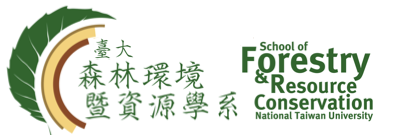Prof. C. Y. Jim演講
演講者:Professor C.Y. Jim
Department of Social Sciences, Education University of Hong Kong, Hong Kong
Prof. C. Y. Jim將於台大提供兩場演講,歡迎有興趣的師生前往參加!
演講一:
時間及地點:9/25 10:00~12:00 地理系305教室
講題:
"The pride of urban forestry: Identification and conservation of heritage trees".
演講二:
時間及地點:9/26 10:30~12:00 森林系 林一教室
講題:"The bane of urban forestry: Soil sequestration and solutions".
演講一:The pride of urban forestry: Identification and conservation of heritage trees。
ABSTRACT
Since antiquity, humans have held trees in high esteem or in awe. Primitive people recognized that trees were notably bigger, stronger, more majestic, and longer-living than many organisms. Intimate interactions with nature improved understanding of trees which became pertinent and versatile resources. In time, they conjured up feelings of fraternity, generosity, providence, ubiquity, immortality, eternity and divinity. The mentality began with admiration and respect, evolving to adoration and reverence, and then elevating to veneration and worship. Many indigenous cultures would bestow the sacred standing to individual trees or groves, and considered them to be deities or the abodes of certain spirits. The pragmatic contributions of trees to farming communities in soil and water conservation and microclimatic amelioration are well recognized. Expressed in different forms, in East Asia it has been systematically practised as fengshui or geomancy. They reflect traditional wisdom of learning from nature to create a harmonious and healthy milieu for humans to tackle the capriciousness and harshness of nature. Such indigenous knowledge, translated to adaptive practices, provides a collective community-based and holistic resource management system, sustaining stable agrarian culture over millennia. In modern societies, the sacred members protected for their cultural-cum-natural importance. Local customs as unwritten codes could offer rather assured protection. The superstitious aspects would include certain taboos, the infringement of which could incur the wrath of the deities resulting in dire consequences. For centuries, the fear of supernatural retribution has guarded the precious trees. In managing urban forests, outstanding trees could be designated as a special and valuable cohort and protected by law from development pressure or disturbance. Their worth has been augmented by objective scientific criteria. Generally given the champion, monumental or heritage tree epithets, they include a mixed group recognized by community consensus with quests for conservation. In the spirit of inter-generational responsibility, there is express desire that the inherited treasures shall remain inheritable. The dilution of traditional taboos in cities calls for substitute protection based on statutory and administrative means. Urban forest managers, as custodians of this natural-cum-cultural heritage, could ensure their long-term welfare. Increasing urbanization by intensification and sprawl could threaten urban forests and decimate this tiny but critical tree cohort. Tailor-made measures based on research could ensure their robustness and survival. This study focuses on individual heritage trees dwelling in cities and the urban fringe. The designation yardsticks are evaluated followed by management and conservation measures.
演講二:
時間及地點:9/26 10:30~12:00 森林系 林一教室
講題:"The bane of urban forestry: Soil sequestration and solutions".
ABSTRACT
In high-density or compact urban areas, the competition for the limited space resource is intense, and grey infrastructure prevails over green infrastructure. The tight urban fabric can challenge tree growth due to physical restrictions and physiological stresses, and frustrate efforts to bring greener and healthier cities. Fast urbanization in developing countries and densification in developed ones have intensified the pressure on people and trees. The admirable forest-city goal demands innovative methods and solutions tailor-made to tackle the difficulties. The subaerial tree growth space attracts more attention as it is more discernible and less difficult to ameliorate. The more intractable subterranean constraints are compounded by the inherent human folly of out-of-sight and out-of-mind. The common occurrence of confined soil volume acutely restricts root growth, root spread and tree health, and contributes to premature decline and tree hazard. The main soil quality problems are sealing by impermeable paving, compaction, organic-matter deficit, low nutrient and water holding capacity, and meagre nutrient stock. From recent research findings on urban soils and urban trees, some novel solutions can be distilled to bring effective and sustainable relief. Soil volume expansion can be accompanied by high-quality soil mix to resolve the twin problem. Soil compaction at the planting site can be prevented by suspended paving methods such as supporting piers, supporting frames, and structural soil. In the cramped urban environment, the expanded soil area can be co-used for pedestrians and vehicles. Various creative soil extension techniques can allow tree roots to break out from conventional confined tree pits or tree strips to reach nearby open-soil areas. Subsurface connections from planting site to breakout areas could be facilitated by buried pipes or covered soil corridors. Root systems of existing trees should be protected more assiduously from destructive trenching, grade change and other construction activities. The mature trenchless technology can be applied to underground utility works to protect important trees. More use of porous and pervious paving materials can enhance root growth. Modern subbase design of footpaths adjacent to trees can prevent cracking and heaving of pavement by roots. Degraded soil besetting veteran or heritage trees can be ameliorated by soil rehabilitation methods such as radial trenching and vertical mulching. Urban tree managers can readily adopt out-of-the-box thinking in managing the green companions. Policy makers and practitioners can more promptly be informed by new research findings. Intimate interactions between science and practice can be proactively cultivated.

